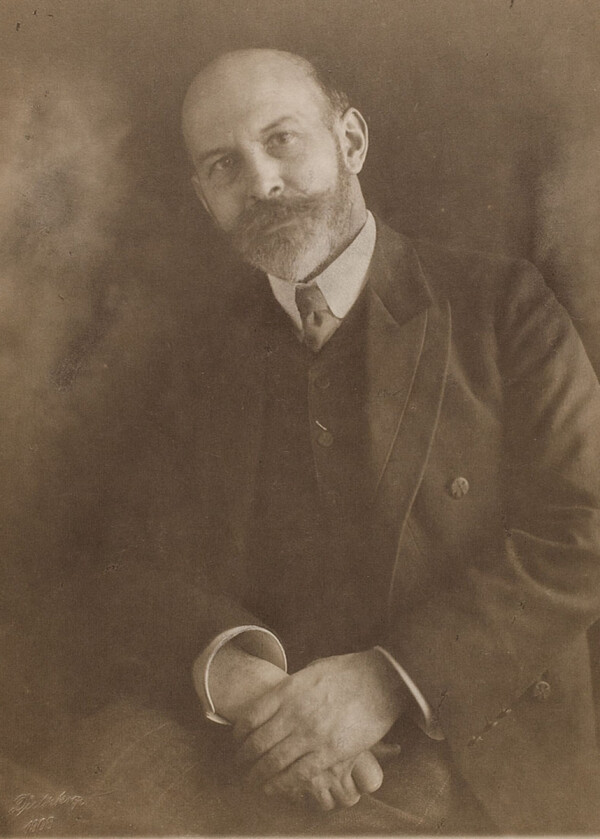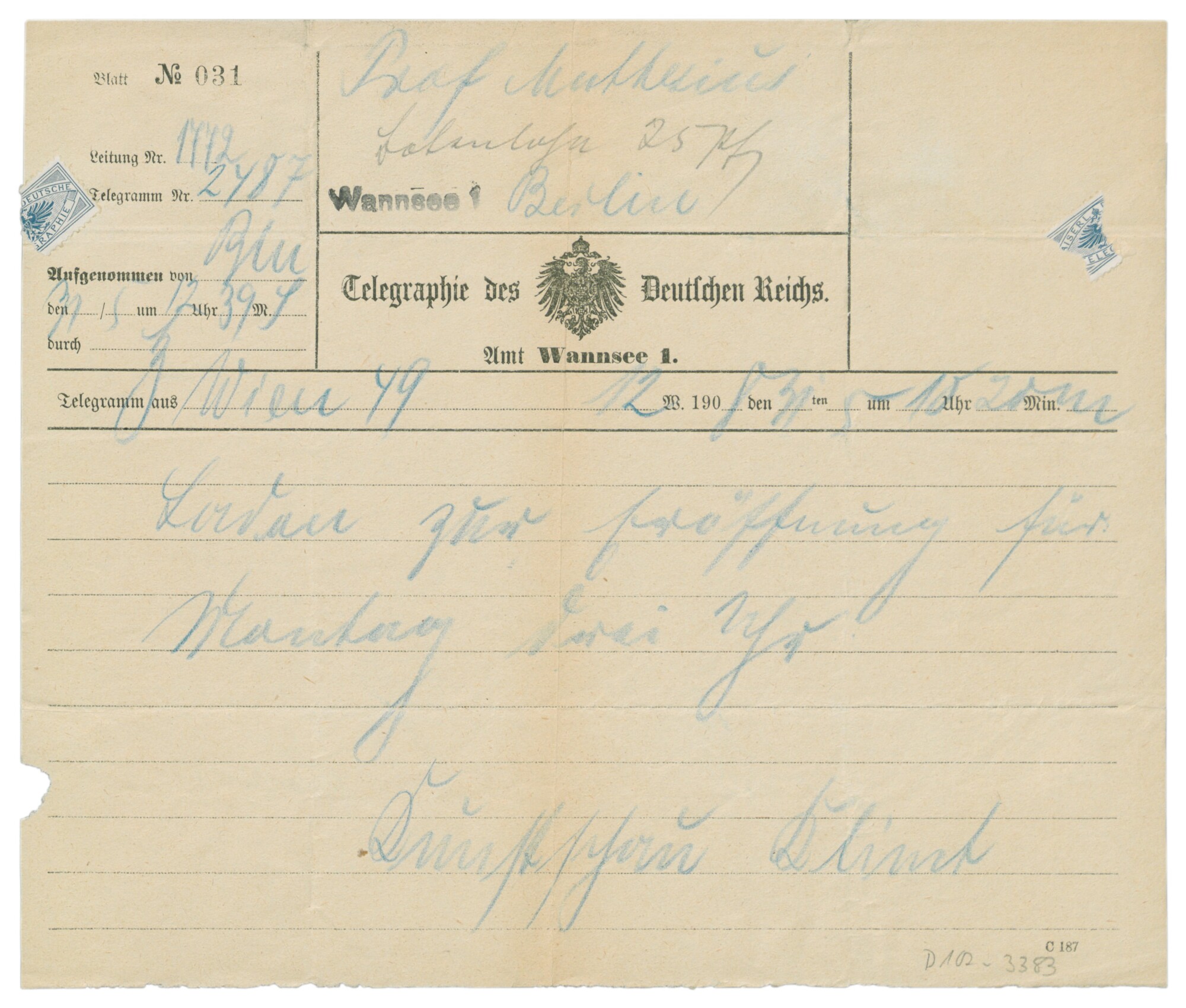Hermann Muthesius

Hermann Muthesius photographed by Rudolph Dührkoop, 1908
© Museum für Kunst und Gewerbe Hamburg
Hermann Muthesius was an important German architect and writer. In 1907 he was involved in the foundation of the Deutscher Werkbund – a transnational association for the “refinement of craftsmanship.” He was acquainted with the painter Gustav Klimt, who visited him in Germany in 1907.
Adam Gottlieb Hermann Muthesius, born in Großneuhausen in Thuringia in 1861, completed his apprenticeship as a mason under his father while also receiving a comprehensive general education. After leaving school, he initially studied philosophy and art history but later switched to architecture. He finished his studies in 1887 and worked in several leading architectural offices and for the Prussian Ministry of Public Works. This enabled him to travel to Japan and Great Britain, where he made a significant impact. During his stay in London he published numerous essays on current developments in English art and architecture. He returned to Germany in 1904, working for the Prussian Ministry of Trade. He was also active as an independent architect, primarily in and around Berlin, where he built numerous country houses.
Foundation of the Deutscher Werkbund (1907)
Muthesius was a resolute critic of Historicism’s stylistic pluralism and a proponent of an objective architectural style. When he postulated his principles at his inaugural lecture at the Berlin Business School in 1907, this led to protests and discussions, prompting, among other things, the establishment of the Deutscher Werkbund, which was founded in Munich in 1907 by architects, artists, and industrialists. A year later, the founders’ congress took place in the same city. Lasting for several days, it was also attended by Gustav Klimt and Josef Hoffmann, among others, as representatives of the Viennese art scene. Muthesius himself was elected the association’s second chairman and would become one of the most important mouthpieces of the Deutscher Werkbund over the next few years.
Retirement
In 1916, Muthesius resigned from his position as second chairman and left the association. The reason for this was primarily internal disputes, which had been triggered by the so-called “typification debate” as early as 1914 and almost led to a split within the Deutscher Werkbund. After World War I, Hermann Muthesius worked as an architect and writer, focusing primarily on issues of contemporary architecture and housing developments. In 1927, one year after his retirement, the architect was killed in a streetcar accident.
Contact with Gustav Klimt
Gustav Klimt and Hermann Muthesius were known to have been acquainted: according to the Neues Wiener Tagblatt, the painter attended Muthesius’s lecture on The English House at the Austrian Museum of Art and Industry (now MAK, Vienna) in March 1906. A year later, in November 1907, Klimt traveled to Berlin and – according to his correspondence with Emilie Flöge – visited the German architect during his stay. Yet the reason for their meeting is unknown. Further evidence of their acquaintance is a telegram now conserved in the Werkbund archives.

Gustav Klimt: Telegram from Gustav Klimt in Vienna to Hermann Muthesius on the Wannsee, 05/31/1908, Werkbundarchiv – Museum der Dinge
© Werkbundarchiv - Museum der Dinge, Berlin
It reveals that Klimt personally invited the architect to the opening of the “Kunstschau Wien” in 1908. It is unknown, however, whether Muthesius actually attended the event. According to an article in the newspaper Die Zeit, he did visit the exhibition in the fall of 1908. Four years later, there were further media reports about a meeting between Klimt and Muthesius. It took place on the occasion of the conference of the Deutscher Werkbund in the Austrian capital, where – according to several newspapers – both attended an evening welcome event at the Vienna Kursalon.
Literature and sources
- Historische Kommission bei der Bayerischen Akademie der Wissenschaften (Hg.): Neue Deutsche Biografie, Band 18, Berlin 1997, S. 651-653.
- Der Architekt. Wiener Monatshefte für Bau- und Raumkunst, 23. Jg. (1920), S. 33-44.
- Neue Freie Presse, 27.10.1927, S. 7.
- Neues Wiener Tagblatt, 06.07.1914, S. 7.
- Die Zeit, 31.10.1908, S. 4.
- Tobias G. Natter, Franz Smola, Peter Weinhäupl (Hg.): Klimt persönlich. Bilder – Briefe – Einblicke, Ausst.-Kat., Leopold Museum (Vienna), 24.02.2012–27.08.2012, Vienna 2012.
- Telegramm von Gustav Klimt in Wien an Hermann Muthesius am Wannsee (31.05.1908). D 102-3383.
- Die Zeit, 13.08.1908, S. 1-2.
- Der Tag, 28.10.1927, S. 5.
- Neues Wiener Tagblatt, 17.07.1908, S. 14.
- Hans Vollmer (Hg.): Allgemeines Lexikon der Bildenden Künstler von der Antike bis zur Gegenwart. Begründet von Ulrich Thieme und Felix Becker, Band XXV, Leipzig 1931, S. 296.
- Andreas Beyer, Bénédicte Savoy, Wolf Tegethoff (Hg.): Allgemeines Künstler-Lexikon. Die bildenden Künstler aller Zeiten und Völker, Band XCI, Berlin - New York 2016, S. 362.
- Neue Freie Presse, 07.06.1912, S. 5-6.
- Neues Wiener Tagblatt, 03.03.1906, S. 7.

